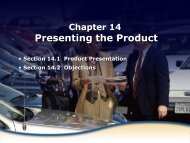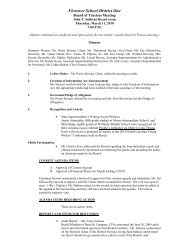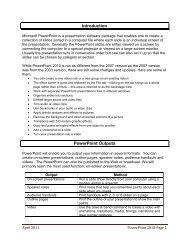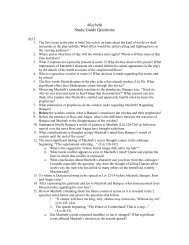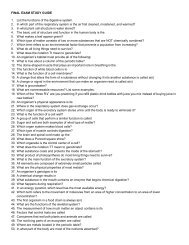Properties and Classifications <strong>of</strong> Matter<strong>PS</strong>-3.5 Explain the effects <strong>of</strong> temperature, particle size, and agitation on the rate at whicha solid dissolves in a liquid.Three basic assumptions <strong>of</strong> kinetic theory.○ All <strong>matter</strong> is composed <strong>of</strong> small particles (molecules, atoms, and ions).○ The particles are in constant, random motion.○ The particles are colliding with each other and the wall <strong>of</strong> their container.Process <strong>of</strong> dissolving in terms <strong>of</strong> the kinetic theory.○ The solvent (in this case water) is composed <strong>of</strong> individual water molecules (H 2 O), all close enough totouch, but in constant motion, moving over, under, and past one another.○ The solute (such as table sugar) is composed <strong>of</strong> crystals.• Each crystal is composed <strong>of</strong> billions <strong>of</strong> individual sugar molecules. The individual molecules areattracted to each other (not <strong>chemical</strong>ly bonded) together. The sugar molecules in the crystal are alsomoving but because sugar is a solid the molecules do not move past each other, they vibrate in place.• Because sugar is a molecular compound, the individual sugar molecules can not be decomposed by aphysical process such as dissolving, so the dissolved sugar remains as sugar molecules and notseparated carbon, hydrogen and oxygen atoms.• The dissolving process involves the sugar molecules being pulled away from each other by the watermolecules but each molecule <strong>of</strong> sugar remains intact.• The sugar molecules on the surface <strong>of</strong> the crystal are the only ones to dissolve because they are theones in contact with the water molecules. As surface sugar molecules dissolve, they expose the onesbeneath to the water.• Because the dissolved sugar molecules are surrounded by water molecules, they are not attracted toeach other (the water molecules block the attractive force).• In the resulting solution, the sugar molecules are distributed throughout the water.• The water can be removed by boiling the water or allowing it to evaporate. When the water boils orevaporates away, the sugar molecules will once again be attracted to each other and sugar crystalswill reform.Temperature affects the rate at which substances dissolve.○ The higher the temperature, the faster the rate <strong>of</strong> dissolving for a solid in a liquid.○ At higher temperatures more <strong>of</strong> the solvent molecules are moving faster and collisions with the surface<strong>of</strong> the solute occur more <strong>of</strong>ten carrying <strong>of</strong>f particles <strong>of</strong> the solute so dissolving occurs more rapidly.Particle size affects the rate at which substances dissolve.○ The smaller the size <strong>of</strong> the pieces <strong>of</strong> solute, the faster they dissolve.○ The smaller the size <strong>of</strong> the individual pieces, the more surface area the sample will have to be in contactwith the water molecules. With more surface area in contact the water molecules, the water will havemore opportunities to pull the solute molecules away from the solute’s surface, thereby, dissolving itfaster.Agitation (stirring or shaking) affects the rate at which substances dissolve.○ The more the solution is agitated, the faster the rate <strong>of</strong> dissolving for a solid in a liquid.○ When a solution is agitated, the water particles collide with the surface <strong>of</strong> the solute more frequently andthe dissolving process occurs faster.If a substance is soluble in water, it will eventually dissolve even if the size <strong>of</strong> the sample pieces <strong>of</strong> soluteare large, the temperature is low and there is no agitation.Do not confuse the rate <strong>of</strong> dissolving (how fast a substance dissolves) with solubility (the degree to which onesubstance is able to dissolve in another –ex. Oil(nonpolar) does not dissolve in water(polar); alcohol doesdissolve in water because both are polar)6 / 10
Properties and Classifications <strong>of</strong> Matter<strong>PS</strong>-3.6 Compare the <strong>properties</strong> <strong>of</strong> the four states <strong>of</strong> <strong>matter</strong>—solid, liquid, gas, andplasma—in terms <strong>of</strong> the arrangement and movement <strong>of</strong> particles.Kinetic theorySolidsLiquidsGasesPlasma The particles <strong>of</strong> solids are closely packed together because there is an attractive forceholding them together The particles <strong>of</strong> solids are constantly vibrating, but they do not readily slip past oneanother. Because the particles vibrate in place and do not readily slip past one another, a solid hasa definite shape. The particles <strong>of</strong> liquids are in contact with each other because there is an attractive forceholding them together. The particles <strong>of</strong> liquids have enough energy to partially overcome the attractive force <strong>of</strong>the surrounding particles. Liquid particles can slip past surrounding particles and slideover one another. Because the particles slip past one another, a liquid does not have adefinite shape and so takes the shape <strong>of</strong> the container. A sample <strong>of</strong> a liquid can bepoured. The particles <strong>of</strong> gases are not in contact with each other because they have enough energyto completely overcome the attractive force between or among the particles. The particles <strong>of</strong> gases are moving randomly, in straight lines until they bump into otherparticles or into the wall <strong>of</strong> the container. When a particle hits another particle or thecontainer, it bounces <strong>of</strong>f and continues to move. Because gas particles move independently, the particles move throughout the entirecontainer. The forces between the particles are not strong enough to prevent the particlesfrom spreading to fill the container in which the gas is located. Plasma is <strong>matter</strong> consisting <strong>of</strong> positively and negatively charged particles. A substance is converted to the plasma phase at very high temperatures, such as those onin stars (such as the sun). High temperature means that the particles <strong>of</strong> a substance aremoving at high speeds. At these speeds, collisions between particles result in electronsbeing stripped from atoms. Plasma is the most common state <strong>of</strong> <strong>matter</strong> in the universe, found not only in stars, butalso in lightning bolts, neon and fluorescent light tubes and auroras.Be Careful! At a given temperature, all <strong>matter</strong> has the same average kinetic energy. In each sample there areparticles moving at all different rates <strong>of</strong> speed. As temperature increases, more particles move fast, fewerparticles move slowly. The reason that various types <strong>of</strong> <strong>matter</strong> are in various phases at a given temperature isprimarily due to the variation in the strength <strong>of</strong> the forces between the particles <strong>of</strong> various substances.Materials change phase when they absorb enough energy to break/overcome the attractions between theparticles <strong>of</strong> which they are composed.7 / 10







